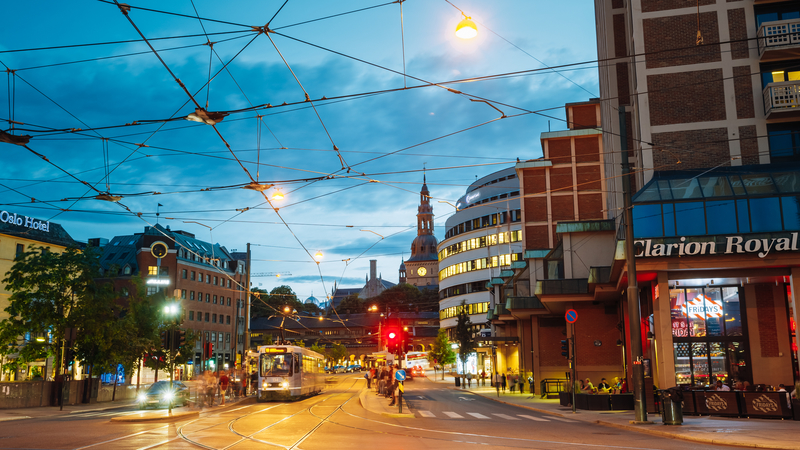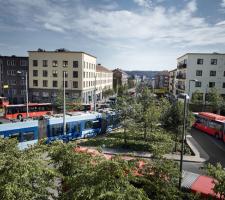
If you replace today’s traditional private car ownership with a mixture of Mobility as a Service (
That, at least, is the view of researchers from COWI and PTV, who have modelled a variety of future scenarios based on the morning rush hours in a working day in Norway’s capital, Oslo.
The city is this year’s European Green Capital, and wants to reduce car use by a third before 2030. However, The Oslo Study – How autonomous cars may change transport in cities found that traffic would get worse without ride-sharing.
Delicate flavours
Getting the mobility mix right is clearly going to be a delicate balance of flavours. “The integration of MaaS systems into existing public transport is likely to lead to even better results concerning traffic reduction,” the study says. “But it would be worse too if MaaS “became more attractive than traditional public transport.”
Carried out on behalf of regional public transport operator Ruter, the study shows that “in the most optimistic scenario a reduction of 14 % traffic is possible”. But researchers also warn that the traffic reduction potential is less than estimated from previous studies in Lisbon and Helsinki: “This can partially be explained by the lower population density in the Oslo region.”
Another caveat about the results is that population growth could offset the reduction – which means that, in the coming years, traffic could grow anyway if planners get the balance wrong. In other circumstances, traffic volumes would double, resulting in a complete meltdown of the system.
However, the Oslo study “assumes a very high level of service”, where users get what they want, more or less immediately. If people were instead happy with longer waiting times before a vehicle shows up, or would put up with longer detours, “the effect on traffic will be substantially better”, with traffic volumes reduced by up to 31%, the researchers conclude.
Self-driving technology will in itself not help achieve climate targets or promote better urban development, says Øystein Berge, project manager for the Oslo study at COWI. “But if we manage to use the technology to increase ride-sharing and make traditional public transport more attractive, it will be an important part of the move towards more sustainable mobility in our cities,” he adds.
Planning future infrastructure needs is difficult, notes Paul Speirs, PTV’s director for project management & services. “For instance, will today’s car ownership be the same in the future? Will AVs increase our desire to travel more? How quickly will society adopt AVs?”
PTV’s MaaS Modeller software can simulate multiple combinations of assumptions which produce a range of future outcomes. “When you understand the range of results and which assumptions have a greater or lesser influence on the outcome, stakeholders can make big decisions with increased confidence,” Speirs says.
The report looks at four main scenarios where today’s passenger groups switch to shared, autonomous transport – both with and without ride-sharing.
If people in Oslo and Akershus all share cars and use ride-sharing, 7% of cars on the road today will be sufficient to cover all journeys in the rush hour. In other words, 93% will be redundant.
The 14% reduction in traffic comes where users of public transport continue to do so while car drivers switch to ride-share. However, traffic volumes would increase by 97% if everyone who currently drives (and everyone who uses public transport) switched to car-share - but without ride-sharing.
If the same group uses ride-sharing, traffic will increase by 31%. On the other hand, if today’s public transport users switch to MaaS-based systems with ride-share, their journey time will be reduced by an average of 11 minutes.
For private car users, average journey time will increase by six minutes without ride-share and eight minutes with.
Whichever way you cut it, a good public transport system is still going to be important: its users will see journey times reduced most by switching to autonomous MaaS concepts.
On the other hand, MaaS systems could make public transport more attractive to people who currently drive their own cars.
“This is one of the most complex analyses ever carried out on this topic anywhere in the world,” says Berge. “The level of detail in the report is very high.”
Researchers are open about the gaps in the report: the fundamental one is that all of the scenarios are at the extreme end of the spectrum. More realistic ‘what ifs’ need to be explored – for instance, one where AVs feed mass transit as a first/last-mile service.
Having said that, the study puts some big questions out there: would people prefer to be alone, or would we share trips with strangers? Will only car drivers adopt new concepts, or will bus and tram commuters also shift towards MaaS solutions? If so, will that shift be to services similar to car users or to something more like traditional public transport?
The Oslo Study – How autonomous cars may change transport in cities is a thought-provoking contribution to the debate about how AVs are actually going to work with concepts such as MaaS, and what effect they might really have on people’s everyday lives.
As the report points out: “AVs can help reaching the target, when integrated in a larger mobility system, but can worsen the situation if they are used as cars are today.”
This makes clear that we cannot solely rely on AVs in a MaaS concept; traditional public transport - combined with cycling and walking – will have to be used too.
Four scenarios for Oslo future transport
1a Car users change mode to shared car without ride-sharing. Public transport riders do not change mode and continue to ride public transport.
1b Car users change to shared taxi with ride-sharing. Public transport riders do not change mode and continue to ride public transport.
2a Car users change to shared cars, without ride-sharing. Public transport riders on buses and trams change to shared car, without ride-sharing. Train and metro riders continue without changing.
2b Car users change to shared taxi with ride-sharing. Public transport riders on buses and trams change to shared taxi with ride-sharing. Train and metro riders continue without changing.
In scenario 1a and 1b today’s public transport users will continue to use public transport - but private car users switch to a MaaS option. In 2a and 2b, all buses and trams will be replaced by a fleet of AVs providing on-demand door-to-door services. In 1a and 2a, vehicles will be shared - but there will be no ride-sharing. In 1b and 2b, all transport will allow ride-sharing. The scenarios assume that users will act coherently as a group based on their modal choice when choosing their new transportation method. Either all public transportation riders will continue to use traditional public transport as today, or all public transportation riders who use buses and trams will shift to MaaS solutions. Train and metro users will not change their behaviour in any of the scenarios. In scenarios with only trains and metros, the remaining public transportation modes will be replaced by the new MaaS offers.
Source: The Oslo Study – How autonomous cars may change transport in cities













